 Open Access Article
Open Access ArticleCreative Commons Attribution 3.0 Unported Licence
Synthesis of benzo[b]furans from alkynyl sulfoxides and phenols by the interrupted Pummerer reaction†
Akihiro Kobayashiab,
Tsubasa Matsuzawab,
Takamitsu Hosoya b and
Suguru Yoshida
b and
Suguru Yoshida *a
*a
aDepartment of Biological Science and Technology, Faculty of Advanced Engineering, Tokyo University of Science, 6-3-1 Niijuku, Katsushika-ku, Tokyo 125-8585, Japan. E-mail: s-yoshida@rs.tus.ac.jp
bLaboratory of Chemical Bioscience, Institute of Biomaterials and Bioengineering, Tokyo Medical and Dental University (TMDU), 2-3-10 Kanda-Surugadai, Chiyoda-ku, Tokyo 101-0062, Japan
First published on 3rd January 2023
Abstract
The interrupted Pummerer reaction of alkynyl sulfoxides with phenols is disclosed. A wide range of benzo[b]furans were efficiently synthesized through unexplored electrophilic activation of the electron-deficient alkynyl sulfinyl group. Based on the good availability of alkynyl sulfoxides, we successfully prepared various functionalized benzo[b]furans from readily available alkynes, thiosulfonates, and phenols.
Introduction
Benzo[b]furan scaffolds are of great importance in a wide range of research fields including pharmaceutical sciences, natural product chemistry, and materials chemistry (Fig. 1A).1 Various methods to synthesize benzofurans have been developed so far. For example, O-alkylation of salicylaldehyde derivatives with chloroacetic acid and subsequent cyclization affords a range of benzofurans.2 Despite the significance of benzofurans, the synthesis of highly functionalized benzofurans is not easy by conventional methods due to limitations in the benzofuran skeleton construction. We herein describe a new method to prepare multisubstituted benzofurans from alkynyl sulfoxides and phenols via the interrupted Pummerer reaction.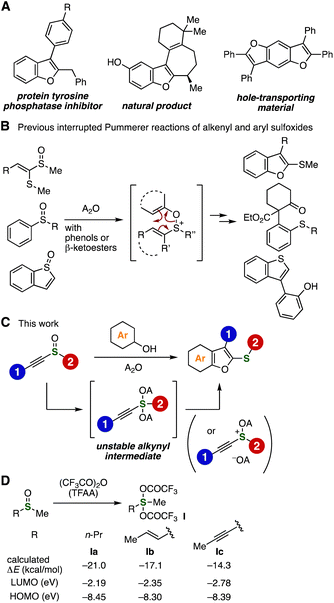 | ||
| Fig. 1 Backgrounds and an abstract of this study. (A) Significant benzofurans. (B) Interrupted Pummerer reactions. (C) This work. (D) DFT calculations of sulfuranes Ia–Ic. ΔE = E(sulfuranes) − E(sulfoxides) − E(TFAA). See ESI† for details. | ||
The interrupted Pummerer reactions are emerging methods to synthesize highly functionalized organosulfur compounds from sulfoxides by the electrophilic activation of S![[double bond, length as m-dash]](https://www.rsc.org/images/entities/char_e001.gif) O bonds (Fig. 1B).3 Recently, several unique transformations of a range of alkenyl and aryl sulfoxides with various nucleophiles have been achieved through the electrophilic activation of the sulfoxide moieties followed by smooth charge-accelerated [3,3]-sigmatropic rearrangement.4,5 In contrast, interrupted Pummerer reactions of alkynyl sulfoxides have not been developed to the best of our knowledge, which may be due to the electron-deficient nature of the sulfoxide moiety by the electron-withdrawing sp-hybridized carbon. We conceived that the interrupted Pummerer reaction of alkynyl sulfoxides with phenols with the appropriate activators will allow us to synthesize a wide variety of functionalized benzofurans owing to the good availability of alkynyl sulfoxides and phenols (Fig. 1C).
O bonds (Fig. 1B).3 Recently, several unique transformations of a range of alkenyl and aryl sulfoxides with various nucleophiles have been achieved through the electrophilic activation of the sulfoxide moieties followed by smooth charge-accelerated [3,3]-sigmatropic rearrangement.4,5 In contrast, interrupted Pummerer reactions of alkynyl sulfoxides have not been developed to the best of our knowledge, which may be due to the electron-deficient nature of the sulfoxide moiety by the electron-withdrawing sp-hybridized carbon. We conceived that the interrupted Pummerer reaction of alkynyl sulfoxides with phenols with the appropriate activators will allow us to synthesize a wide variety of functionalized benzofurans owing to the good availability of alkynyl sulfoxides and phenols (Fig. 1C).
Before examining the benzofuran synthesis, we evaluated the stability of alkynyl sulfurane intermediate Ic compared to alkenyl and alkyl sulfuranes Ia and Ib by the DFT calculation (Fig. 1D). The calculated energy differences between sulfoxides with trifluoroacetic anhydride (TFAA) and sulfuranes Ia–Ic showed that the electron-deficient alkynyl sulfurane Ic is unstable in comparison with alkyl and alkenyl sulfuranes Ia and Ib. These results clearly show that stability of sulfurane Ic was decreased by the significant electron-deficiency of alkynyl carbons. Comparing LUMO energies of Ia–Ic suggests higher electrophilicity of alkynyl sulfurane Ic than that of alkyl and alkenyl sulfuranes Ia and Ib.
Results and discussion
After screening the reaction conditions, we established the synthetic method of benzofuran 3a from phenol (1a) and alkynyl sulfoxide 2a through electrophilic sulfoxide activation (Table 1). While benzofuran 3a was not obtained when acetic anhydride was used as an activator (entry 1), we found that treating a mixture of phenol (1a) and alkynyl sulfoxide 2a with triflic anhydride (Tf2O) afforded 3-butyl-2-(ethylthio)benzo[b]furan (3a) in moderate yield (entry 2). The yield was improved by the addition of 2,6-di(tert-butyl)pyridine as a base (entry 3).6 We accomplished the synthesis of benzofuran 3a from 1a and 2a in dichloromethane with TFAA in excellent yield (entry 4).7 Benzofuran 3a was also prepared in 1 mmol scale without decreasing the yield, showing the good scalability of the protocol (entry 5). Although we failed the synthesis of benzofuran 3a when using 2,6-di(tert-butyl)pyridine or triethylamine as an additive (entries 6 and 7), benzofuran 3a was also obtained in the presence of sodium carbonate (entry 8). Among solvents examined (entries 4 and 9–12), dichloromethane, toluene, and α,α,α-trifluorotoluene were effective for benzofuran synthesis (entries 4, 11, and 12). Trifluoroacetic acid did not activate sulfoxide 2a (entry 13).| Entry | Activator | Additive | Solv. | Yielda (%) |
|---|---|---|---|---|
| a 1H NMR yield.b Isolated yield (0.1 mmol scale).c Isolated yield (1 mmol scale). | ||||
| 1 | Ac2O | None | CH2Cl2 | 0 |
| 2 | Tf2O | None | CH2Cl2 | 45 |
| 3 | Tf2O | 2,6-(t-Bu)2pyridine | CH2Cl2 | 81 |
| 4 | TFAA | None | CH2Cl2 | 97 (94)b |
| 5 | TFAA | None | CH2Cl2 | 95c |
| 6 | TFAA | 2,6-(t-Bu)2pyridine | CH2Cl2 | 0 |
| 7 | TFAA | NEt3 | CH2Cl2 | 0 |
| 8 | TFAA | Na2CO3 | CH2Cl2 | 89 |
| 9 | TFAA | None | MeCN | 67 |
| 10 | TFAA | None | THF | 0 |
| 11 | TFAA | None | Toluene | 85 |
| 12 | TFAA | None | PhCF3 | 91 |
| 13 | CF3CO2H | None | CH2Cl2 | 0 |
With optimized conditions in hand, a wide range of 2-sulfanylbenzofurans 3 were synthesized from phenol (1a) and various alkynyl sulfoxides 2 (Fig. 2). For example, phenethyl-substituted benzofuran 3b was synthesized in good yield. It is worthy to note that an ester moiety was tolerated under the conditions, providing benzofuran 3c in high yield. We succeeded in the synthesis of ether-tethered benzofuran 3d by electrophilic activation with Tf2O in the presence of 2,6-di(tert-butyl)pyridine in good yield, where decomposition took place when the reaction was conducted with TFAA. Benzofurans 3e and 3f having aryl groups at 3-position were prepared efficiently without damaging 4-tolyl and 4-chlorophenyl groups. Also, alkynyl aryl sulfoxides participated to the benzofuran synthesis affording 3g and 3h bearing 4-tolylthio and 4-bromophenylthio groups in high yields. Since a wide variety of alkynyl sulfoxides were easily available from terminal alkynes or alkynylsilanes,8 the broad scope of the benzofuran synthesis is a great advantage over previous reports.4
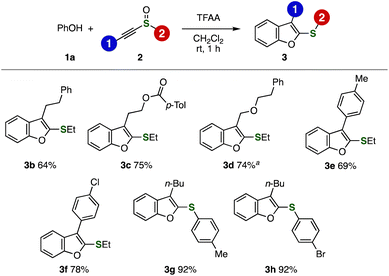 | ||
| Fig. 2 Syntheses of benzofurans 3 using various alkynyl sulfoxides 2. See the ESI† for details. aThe reaction was performed with Tf2O and 2,6-di(tert-butyl)pyridine. | ||
Diverse functionalized benzofurans were successfully synthesized from alkynyl sulfoxide 2a and a broad variety of phenols (Fig. 3). Indeed, phenols having methyl, methoxy, bromo, chloro, and methoxycarbonyl groups served in the benzofuran synthesis with alkynyl sulfoxide 2a in moderate to high yields keeping the functional groups unreacted. Furthermore, the reaction of 2-trimethylsilyl-3-triflyloxyphenol (1h) with alkynyl sulfoxide 2a efficiently proceeded to furnish benzofuran 3o leaving butyl, ethylthio, trimethylsilyl, and triflyloxy groups untouched. In addition, naphthofuran 3p was synthesis from 1-naphthol (1i) in good yield.
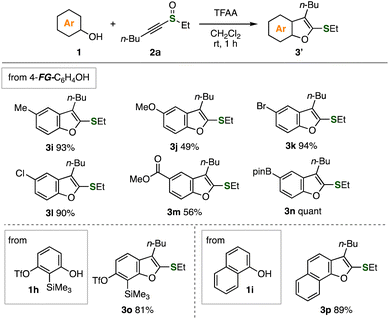 | ||
| Fig. 3 Syntheses of benzofurans 3 using various phenols. See the ESI† for details. | ||
We then examined the regioselectivity in the benzofuran synthesis (Fig. 4). When the benzofuran synthesis was performed using m-cresol, 6-methyl-substituted benzofuran 4a was majorly obtained along with 4-methylbenzofuran 5a with moderate regioselectivity, clearly showing that the C–C bond formation at the unhindered site was favorable. Benzofuran 4b was also synthesized as a major product with good regioselectivity when using 5-hydroxyindane (1k). Of note, we succeeded in the preparation of benzofuran 4c as a sole product, in which the C–C bond formation at the vacant position took place selectively and regioisomer 5c was not observed. In contrast, naphthols 1m and 1n reacted with alkynyl sulfoxide 2a at the hindered site affording naphthofurans 5d and 5e selectively without forming regioisomers 4d and 4e, where cyclization took place at more electron-rich carbons.9 Moreover, we achieved the synthesis of benzofuran-fused benzofurans 4f and 5f in good yields, in which C–C bond formation at 4-position occurred primarily in moderate selectivity.
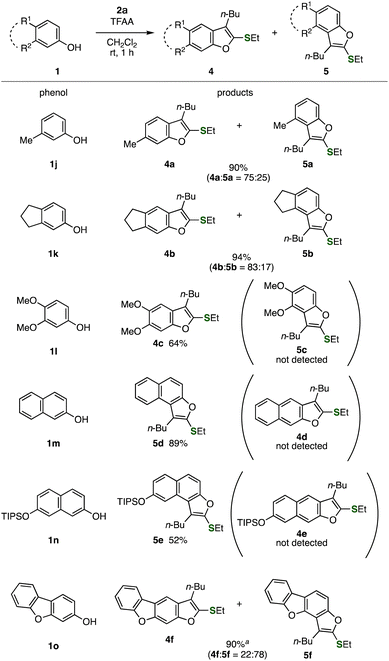 | ||
| Fig. 4 Syntheses of benzofurans 4 and 5 using various phenols. See the ESI† for details. a 1H NMR yield. Authentic samples (4f 7%; 5f 65%) were isolated respectively. | ||
To clarify the reaction mechanism of the benzofuran formation, we conducted control experiments (Fig. 5A). In order to examine the stability of intermediates generated in situ by the electrophilic activation of sulfoxides, we performed the addition of aqueous sodium bicarbonate or phenol (1a) after the prior activation of alkynyl sulfoxide 2a with TFAA in dichloromethane for 1 h at room temperature (Fig. 5A). As a result, sulfoxide 2a or benzofuran 3a was respectively obtained through the hydrolysis or the reaction with phenol (1a) in slightly decreased yields, suggesting that side reactions such as the Pummerer rearrangement did not take place smoothly even in the absence of phenols.10
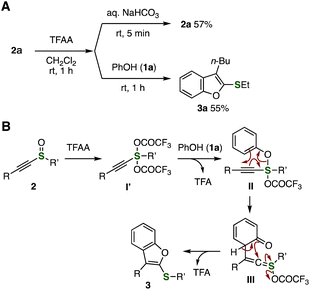 | ||
| Fig. 5 Control experiments and reaction mechanism. (A) The reaction of alkynyl sulfoxide 2a with TFAA. (B) Plausible reaction mechanism. See the ESI† for details. | ||
A plausible reaction mechanism is shown in Fig. 5B. First, the formation of sulfurane intermediates I′ from alkynyl sulfoxides 2 by the electrophilic activation with TFAA followed by the nucleophilic substitution with 1a would afford intermediates II.3 Because side-products by the C–C bond formation of activated alkynyl sulfoxides I′ with 1a at para-position were not observed,11 smooth S–O bond formation providing intermediates II would take place as previously reported interrupted Pummerer reactions.4 Then, the sigmatropic rearrangement of alkynyl sulfuranes II and subsequent deprotonation lead to benzofurans 3.12
Then, we showcased the benefits of the benzofuran synthesis from alkynyl sulfoxides and phenols (Fig. 6). A variety of benzofurans 3q–3s were efficiently synthesized from alkyl halides 6a–6c, sodium thiosulfonate, 1-hexyne, and phenol since sodium thiosulfonate worked as an “+S−” equivalent (Fig. 6A). Indeed, the preparation of alkynyl sulfides by S-alkylation and S-alkynylation followed by S-oxidation and the benzofuran formation allowed us to access easily functionalized benzofurans by the four-step four-component coupling protocols in a modular synthetic manner.
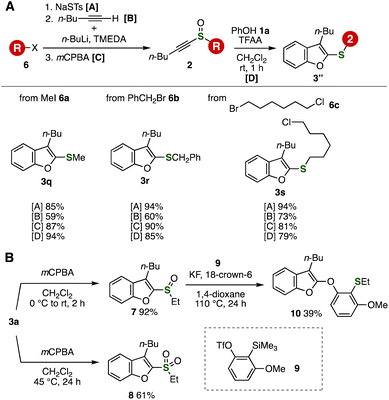 | ||
| Fig. 6 (A) Benzofuran synthesis from alkyl halides. (B) Synthesis of organosulfur compounds from 3a. | ||
The good transformability of the sulfanyl group served in synthesizing a wide range of benzofurans (Fig. 6B). For example, we succeeded in the preparation of sulfoxide 7 and sulfone 8 by S-oxidation of 3a. Since a variety of transformations of the sulfinyl groups can be accomplished, the benzofuran formation and following S-oxidation and subsequent transformations such as aryne reactions13,14 realize the synthesis of highly functionalized benzofurans. Indeed, the migratory oxythiolation of 3-methoxybenzyne from o-silylaryl triflate 9 and sulfoxide 7 with potassium fluoride and 18-crown-6 in 1,4-dioxane at 110 °C took place smoothly to provide highly functionalized benzofuran 10 via the C–S and two C–O bond formations, in which the migration of the 3-butylbenzofuran-2-yl group selectively proceeded in the C–O bond formation.14
Conclusions
In conclusion, we found a new method to synthesize benzo[b]furans from alkynyl sulfoxides and phenols by the electrophilic activation of the electron-deficient alkynyl sulfinyl moiety. Owing to the ready availability of alkynyl sulfoxides, the efficient synthetic method enabled us to prepare a wide range of functionalized benzofurans having sulfanyl groups. Since organosulfur substituents are easily transformed into various functional groups, the benzofuran synthesis will serve in developing diverse bioactive molecules. Further studies such as theoretical calculations are ongoing in our laboratory.Conflicts of interest
There are no conflicts to declare.Acknowledgements
The authors thank Central Glass Co., Ltd for providing Tf2O. This work was supported by JSPS KAKENHI Grant Number JP22H02086 (S. Y.), Uehara Foundation (S. Y.), and JST SPRING Grant Number JPMJSP2120 (A. K.).Notes and references
- For selected examples, see: (a) A. D. Patil, A. J. Freyer, L. Killmer, P. Offen, B. Carte, A. J. Jurewicz and R. K. Johnson, Tetrahedron, 1997, 53, 5047 CrossRef CAS; (b) M. S. Malamas, J. Sredy, C. Moxham, A. Katz, W. Xu, R. McDevitt, F. O. Adebayo, D. R. Sawicki, L. Seestaller, D. Sullivan and J. R. Taylor, J. Med. Chem., 2000, 43, 1293 CrossRef CAS PubMed; (c) H. Tsuji, C. Mitsui, L. Ilies, Y. Sato and E. Nakamura, J. Am. Chem. Soc., 2007, 129, 11902 CrossRef CAS PubMed.
- A. W. Burgstahler and L. R. Worden, Org. Synth., 1966, 46, 28 CrossRef CAS.
- For reviews, see: (a) S. K. Bur and A. Padwa, Chem. Rev., 2004, 104, 2401 CrossRef CAS PubMed; (b) L. H. S. Smith, S. C. Coote, H. F. Sneddon and D. J. Procter, Angew. Chem., Int. Ed., 2010, 49, 5832 CrossRef CAS PubMed; (c) H. Yorimitsu, Chem. Rec., 2017, 17, 1156 CrossRef CAS PubMed; (d) D. Kaiser, I. Klose, R. Oost, J. Neuhaus and N. Maulide, Chem. Rev., 2019, 119, 8701 CrossRef CAS PubMed.
- For selected examples, see: (a) T. Kobatake, D. Fujino, S. Yoshida, H. Yorimitsu and K. Oshima, J. Am. Chem. Soc., 2010, 132, 11838 CrossRef CAS PubMed; (b) X. Huang and N. Maulide, J. Am. Chem. Soc., 2011, 133, 8510 CrossRef CAS PubMed; (c) Y. Ookubo, A. Wakamiya, H. Yorimitsu and A. Osuka, Chem. Eur. J., 2012, 18, 12690 CrossRef CAS PubMed; (d) K. Murakami, H. Yorimitsu and A. Osuka, Angew. Chem., Int. Ed., 2014, 53, 7510 CrossRef CAS PubMed; (e) H. J. Shrives, J. A. Fernández-Salas, C. Hedtke, A. P. Pulis and D. J. Procter, Nat. Commun., 2017, 8, 14801 CrossRef PubMed; (f) K. Okamoto, M. Hori, T. Yanagi, K. Murakami, K. Nogi and H. Yorimitsu, Angew. Chem., Int. Ed., 2018, 57, 14230 CrossRef CAS PubMed; (g) K. Yang, A. P. Pulis, G. J. P. Perry and D. J. Procter, Org. Lett., 2018, 20, 7498 CrossRef CAS PubMed; (h) M. Hori, T. Yanagi, K. Murakami, K. Nogi and H. Yorimitsu, Bull. Chem. Soc. Jpn., 2019, 92, 302 CrossRef CAS; (i) T. Yanagi, K. Nogi and H. Yorimitsu, Synlett, 2020, 31, 153 CrossRef CAS.
- For recent examples, see: (a) X. Meng, D. Chen, X. Cao, J. Luo, F. Wang and S. Huang, Chem. Commun., 2019, 55, 12495 RSC; (b) J. Li, Y. Chen, R. Zhong, Y. Zhang, J. Yang, H. Ding and Z. Wang, Org. Lett., 2020, 22, 1164 CrossRef CAS PubMed; (c) K. Okamoto, K. Nogi and H. Yorimitsu, Org. Lett., 2020, 22, 5540 CrossRef CAS PubMed; (d) M. Leypold, K. A. D'Angelo and M. Movassaghi, Org. Lett., 2020, 22, 8802 CrossRef CAS PubMed; (e) D. Wang, C. G. Carlton, M. Tayu, J. J. W. McDouall, G. J. P. Perry and D. J. Procter, Angew. Chem., Int. Ed., 2020, 59, 15918 CrossRef CAS PubMed; (f) U. Todorović, I. Klose and N. Maulide, Org. Lett., 2021, 23, 2510 CrossRef PubMed; (g) M. Hu, Y. Liu, Y. Liang, T. Dong, L. Kong, M. Bao, Z.-X. Wang and B. Peng, Nat. Commun., 2022, 13, 4719 CrossRef CAS PubMed.
- S. Yoshida, H. Yorimitsu and K. Oshima, Org. Lett., 2009, 11, 2185 CrossRef CAS PubMed.
- When decreasing the amount of TFAA to 1.0 or 1.1 equivalents, the yield was decreased to 74 or 83%, respectively.
- (a) K. Kanemoto, S. Yoshida and T. Hosoya, Org. Lett., 2019, 21, 3172 CrossRef CAS PubMed; (b) E. Godin, J. Santandrea, A. Caron and S. K. Collins, Org. Lett., 2020, 22, 5905 CrossRef CAS PubMed; (c) A. Kobayashi, T. Matsuzawa, T. Hosoya and S. Yoshida, Chem. Commun., 2020, 56, 5429 RSC; (d) Q. Liu, X.-B. Li, M. Jiang, Z.-J. Liu and J.-T. Liu, Tetrahedron, 2021, 83, 131994 CrossRef CAS.
- Treatment of a mixture between 2,6-naphthalenediol and alkynyl sulfide 2a with TFAA afforded a complex mixture of product.
- A. Padwa, D. E. Gunn and M. H. Osterhout, Synthesis, 1997, 1353 CrossRef.
- S. Yoshida, H. Yorimitsu and K. Oshima, Chem. Lett., 2008, 37, 786 CrossRef CAS.
- V. S. P. R. Lingam, R. Vinodkumar, K. Mukkanti, A. Thomas and B. Gopalan, Tetrahedron Lett., 2008, 49, 4260 CrossRef.
- For selected reviews, see: (a) T. Matsuzawa, S. Yoshida and T. Hosoya, Tetrahedron Lett., 2018, 59, 4197 CrossRef CAS; (b) R. Zhang, X. Peng and J. Tan, Synthesis, 2022, 54, 5064 CrossRef CAS.
- T. Matsuzawa, K. Uchida, S. Yoshida and T. Hosoya, Org. Lett., 2017, 19, 5521 CrossRef CAS PubMed.
Footnote |
| † Electronic supplementary information (ESI) available: Experimental procedures, characterization for new compounds including NMR spectra. See DOI: https://doi.org/10.1039/d2ra07856b |
| This journal is © The Royal Society of Chemistry 2023 |

